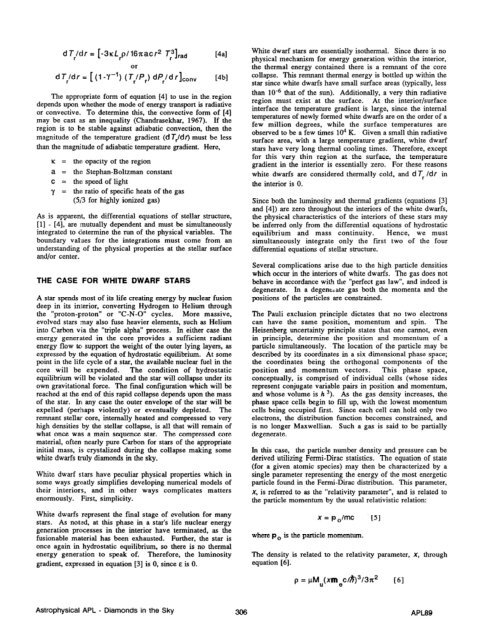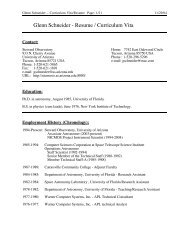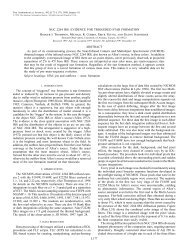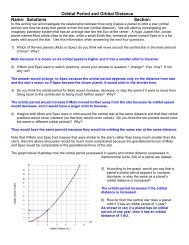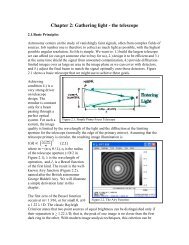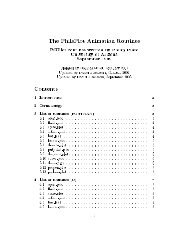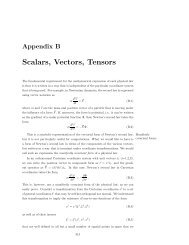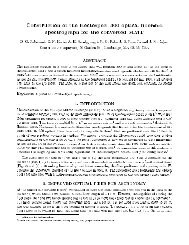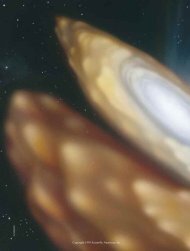ASTROPHYSICAL APL - DIAMONDS IN THE SKY
ASTROPHYSICAL APL - DIAMONDS IN THE SKY
ASTROPHYSICAL APL - DIAMONDS IN THE SKY
You also want an ePaper? Increase the reach of your titles
YUMPU automatically turns print PDFs into web optimized ePapers that Google loves.
d Tidr = [-3KLrp/16nacr2 ~,3]~~~ PaId T/dr = [ (1 -Y-l) (frlPJ dq/d rlconv [4blThe appropriate form of equation [4] to use in the.regiondepends upon whether the mode of energy transport is radiativeor convective. To determine this, the convective form of [4]may be cast as an inequality (Chandrasekhar, 1967). If theregion is to be stable against adiabatic convection, then themagnitude of the temperature gradient (d T,/di) must be lessthan the magnitude of adiabatic temperature gradient. Here,K = the opacity of the regiona = the Stephan-Boltzman constantC = the speed of lighty = the ratio of specific heats of the gas(513 for highly ionized gas)As is apparent, the differential equations of stellar structure,[l] - [4], are ~nutually dependent and must be simultaneouslyintegrated to determine the run of the physical variables. Theboundary values for the integrations must come from anunderstanding of the physical properties at the stellar surfaceand/or center.<strong>THE</strong> CASE FOR WHITE DWARF STARSA star spends most of its life creating energy by nuclear fusiondeep in its interior, converting Hydrogen to Helium throughthe “proton-proton” or “C-N-O” cycles. More massive,evolved stars may also fuse heavier elements, such as Heliuminto Carbon via the “triple alpha” process. In either case theenergy generated in the core provides a sufficient radiantenergy flow to support the weight of the outer lying layers, asexpressed by the equation of hydrostatic equilibrium. At somepoint in the life cycle of a star, the available nuclear fuel in thecore will be expended. The condition of hydrostaticequilibrium will be violated and the star will collapse under itsown gravitational force. The final configuration which will bereached at the end of this rapid collapse depends upon the massof the star. In any case the outer envelope of the star will beexpelled (perhaps violently) or eventually depleted. Theremnant stellar core, internally heated and compressed to veryhigh densities by the stellar collapse, is all that will remain ofwhat once was a main sequence star. The compressed corematerial, often nearly pure Carbon for stars of the appropriateinitial mass, is crystalized during the collapse making somewhite dwarfs truly diamonds in the sky.White dwarf stars have peculiar physical properties which insome ways greatly simplifies developing numerical models oftheir interiors, and in other ways complicates mattersenormously. First, simplicity.White dwarfs represent the final stage of evolution for manystars. As nokd, at this phase in a star’s life nuclear energygeneration processes in the interior have terminated, as thefusionable material has been exhausted. Further, the star isonce again in hydrostatic equilibrium, so there is no thermalenergy generation to speak of. Therefore, the luminositygradient, expressed in equation [3] is 0, since E is 0.White dwarf stars are essentially isothermal. Since there is nophysical mechanism for energy generation within the interior,the thermal energy containedthere is a remnant of the corecollapse. This remnant thermal energy is bottled up within thestar since white dwarfs have small surface areas (typically, lessthan 10e6 that of the sun). Additionally, a very thin radiativeregion must exist at the surface. At the interior/surfaceinterface the temperature gradient is large, since the internaltemperatures of newly formed white dwarfs are on the order of afew million degrees, while the surface temperatures areobserved to be a few times lo4 K. Given a small thin radiativesurface area, with a large temperature gradient, white dwarfstars have very long thermal cooling times. Therefore, exceptfor this very thin region at the surface, the temperaturegradient in the interior is essentially zero. For these reasonswhite dwarfs are considered thermally cold, and d Tr ldr inthe interior is 0.Since both the luminosity and thermal gradients (equations [3]and [4]) are zero throughout the interiors of the white dwarfs,the physical characteristics of the interiors of these stars maybe inferred only from the differential equations of hydrostaticequilibrium and mass continuity. Hence, we mustsimultaneously integrate only the first two of the fourdifferential equations of stellar structure.Several complications arise due to the high particle densitieswhich occur in the interiors of white dwarfs. The gas does notbehave in accordance with the “perfect gas law”, and indeed isdegenerate. In a degent,ate gas both the momenta and thepositions of the particles are constrained.The Pauli exclusion principle dictates that no two electronscan have the same position, momentum and spin. TheHeisenberg uncertainty principle states that one cannot, evenin principle, determine the position and momentum of aparticle simultaneously. The location of the particle may bedescribed by its coordinates in a six dimensional phase space;the coordinates being the orthogonal components of theposition and momentum vectors. This phase space,conceptually, is comprised of individual cells (whose sidesrepresent conjugate variable pairs in position and momentum,and whose volume is h 3). As the gas density increases, thephase space cells begin to fill up, with the lowest momentumcells being occupied first. Since each cell can hold only twoelectrons, the distribution function becomes constrained, andis no longer Maxwellian. Such a gas is said to be partiallydegenerate.In this case, the particle number density and pressure can bederived utilizing Fermi-Dirac statistics. The equation of state(for a given atomic species) may then be characterized by asingle parameter representing the energy of the most energeticparticle found in the Fermi-Dirac distribution. This parameter,X, is referred to as the “relativity parameter”, and is related tothe particle momentum by the usual relativistic relation:x = po/mc [51where p. is the particle momentum.The density is related to the relativityequation [ 61.parameter, X, throughp = pMu(xmec/fi)3/37c2 [61Astrophysical <strong>APL</strong> - Diamonds in the Sky 306 <strong>APL</strong>89


